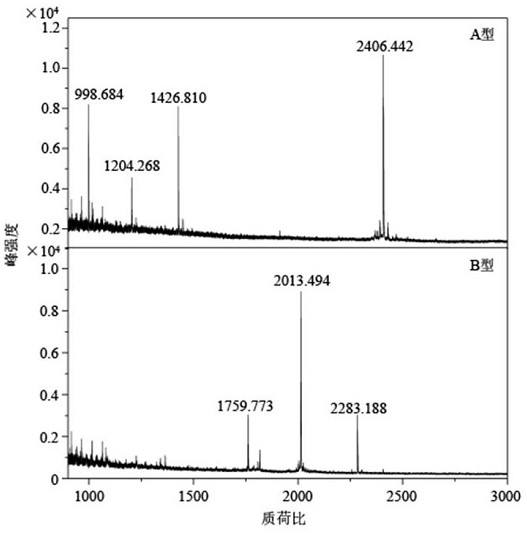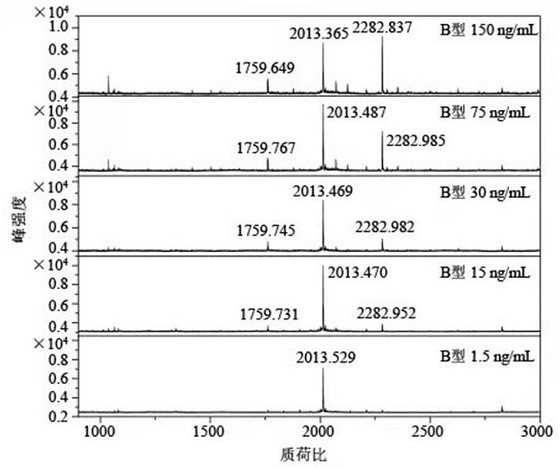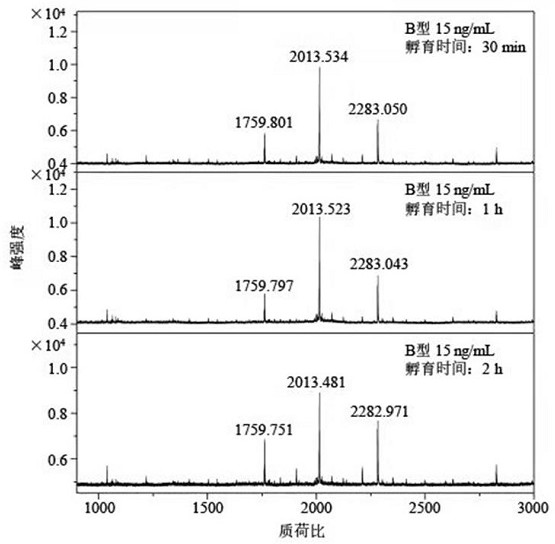Botulinum toxin specific substrate peptide, detection kit and detection method
A detection kit, botulinum toxin technology, applied in the field of analysis and detection, can solve the problems of cumbersome operation, large coefficient of variation of results, long test period, etc.
- Summary
- Abstract
- Description
- Claims
- Application Information
AI Technical Summary
Problems solved by technology
Method used
Image
Examples
Embodiment 1
[0096] Example 1 Determination and synthesis of botulinum toxin serotype-specific substrate peptides
[0097] Through screening and optimization, the present invention obtains four substrate peptides specific for botulinum toxin A, B, E, and F serotypes, respectively, and the amino acid sequences of these four substrate peptides are as shown in SEQ ID NO.1-4 respectively. said.
[0098] The above four substrate peptides are synthesized (synthesized by Shanghai Qiangyao Biotechnology Co., Ltd.), and the synthesized substrate peptides are as follows:
[0099] Type A: Acetyl-RGSNKKPIDAGNQRATRXLGGR-NH 2 ; Wherein, X represents norleucine;
[0100] Type B: LSELDDRAADLQAGASQFESSAAKLKRKYWWKNLK;
[0101] Type E: WWWAKLGQEIDRTNRQKDXIMAKADSNKR-NH 2 ; Wherein, X represents homoarginine;
[0102] Type F: TSNRRLQQTQAQVDEVVDIRMVNVDKVLERDQKLSELDDRADAL.
[0103] After the above-mentioned four substrate peptides are specifically cleaved by their corresponding serotypes of botulinum toxin...
Embodiment 2
[0107] Example 2 Development of botulinum toxin detection kit
[0108] This embodiment provides a botulinum toxin detection kit, which includes reagent 1, reagent 2, reagent 3, reagent 4, reagent 5, reagent 6, and reagent 7;
[0109] Among them, reagent 1 is a PBST solution; reagent 2 is a sample enrichment reagent; reagent 3 is a 1-2 mg / mL BSA solution; reagent 4 is a reaction buffer; reagent 5 is four substrate peptides synthesized in Example 1 (sequences such as SEQ ID NO.1-4); reagent 6 is a saturated solution of α-hydrogen-4-hydroxycinnamic acid (CHCA); reagent 7 is a standard calibration solution of mass spectrometer.
[0110] The composition of the above reaction buffer is as follows: 0.05M Hepes, 25mM DTT, 20μM ZnCl 2 , prepared with ultrapure water.
[0111] The above-mentioned sample enrichment reagent is used to enrich the trace amount of botulinum toxin in the sample, and it contains streptavidin-biotin magnetic bead conjugated antibody. The preparation method is...
Embodiment 3
[0116] Example 3 Establishment of botulinum toxin detection method
[0117] 1. Determination of sample dilution and detection limit
[0118] The botulinum toxin type B sample toxin concentrations were 300 ng / mL, 150 ng / mL, and 30 ng / mL, respectively, diluted 1:1, 1:4, and 1:20 by volume with PBST, and then 20 μL of streptavidin was added. The biotinylated monoclonal antibody was coupled to the magnetic beads and incubated at room temperature for 1 h. After subsequent washing, blocking and enzymatic cleavage reactions, mass spectrometry detection was performed. The optimal dilution factor was determined based on the peak response value of the enzyme digestion mass spectrometer.
[0119] The result is as figure 2 As shown, the peak response value of the enzyme digestion mass spectrum decreases with the increase of the dilution ratio. When the maximum dilution factor is 1:20, the peak of the enzyme-cleavage mass spectrum can still be detected, that is, the detection line of ...
PUM
 Login to View More
Login to View More Abstract
Description
Claims
Application Information
 Login to View More
Login to View More - R&D
- Intellectual Property
- Life Sciences
- Materials
- Tech Scout
- Unparalleled Data Quality
- Higher Quality Content
- 60% Fewer Hallucinations
Browse by: Latest US Patents, China's latest patents, Technical Efficacy Thesaurus, Application Domain, Technology Topic, Popular Technical Reports.
© 2025 PatSnap. All rights reserved.Legal|Privacy policy|Modern Slavery Act Transparency Statement|Sitemap|About US| Contact US: help@patsnap.com



